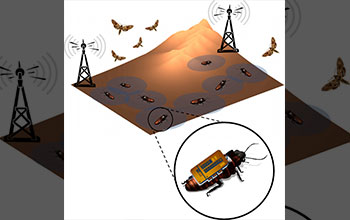Multimedia Gallery
Cyborg swarm maps unknown environments
Researchers at North Carolina State University developed software that allows them to map unknown environments -- such as collapsed buildings -- based on the movement of a swarm of insect cyborgs called "biobots." In this image, biobots explore an unknown environment.
More about this image
North Carolina State University researchers working on the biobot project foccused on how to map areas where there is little or no precise information on where each biobot is, such as a collapsed building where you can’t use GPS technology.
The researchers say in the field, a swarm of biobots, such as remotely controlled cockroaches, would be equipped with electronic sensors and released into a collapsed building or other hard-to-reach area. The biobots would initially be allowed to move about randomly. Because the biobots couldn’t be tracked by GPS, their precise locations would be unknown. However, the sensors would signal researchers via radio waves whenever biobots got close to each other.
Once the swarm has had a chance to spread out, the researchers would send a signal commanding the biobots to keep moving until they find a wall or other unbroken surface – and then continue moving along the wall. This is called "wall following."
The researchers repeat this cycle of random movement and wall following several times, continually collecting data from the sensors whenever the biobots are near each other. The new software then uses an algorithm to translate the biobot sensor data into a rough map of the unknown environment, giving first responders a good idea of the layout in a previously unmapped area.
The research was supported by a grant from the U.S. National Science Foundation (grant CNS 1239243).
Read more about this research in the NC State news story Software uses cyborg swarm to map unknown environs. (Date image taken: September 2013; date originally posted to NSF Multimedia Gallery: Oct. 19, 2017)
Credit: Edgar Lobaton, Department of Electrical and Computer Engineering, North Carolina State University
Images and other media in the National Science Foundation Multimedia Gallery are available for use in print and electronic material by NSF employees, members of the media, university staff, teachers and the general public. All media in the gallery are intended for personal, educational and nonprofit/non-commercial use only.
Images credited to the National Science Foundation, a federal agency, are in the public domain. The images were created by employees of the United States Government as part of their official duties or prepared by contractors as "works for hire" for NSF. You may freely use NSF-credited images and, at your discretion, credit NSF with a "Courtesy: National Science Foundation" notation.
Additional information about general usage can be found in Conditions.
Also Available:
Download the high-resolution JPG version of the image. (177.3 KB)
Use your mouse to right-click (Mac users may need to Ctrl-click) the link above and choose the option that will save the file or target to your computer.

